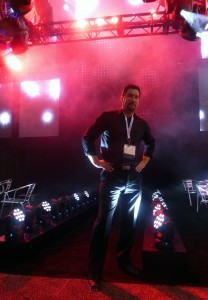Video in the World of Lighting – Part 3
Posted on June 20, 2012Written by Mike Graham, product manager for CHAUVET Professional
By now, you know what kind of show you are doing and what it is going to look like. The plot is finished up and all of your gear is in pretty rows of road cases on your show site.
Now what?
Here are a few things you need to know before you start loading in:
1. What kind of rigging kits are you using?
For example, the MVP modular video panels CHAUVET Professional offers use an individual rig kit. That is to say that every point of the panels attaches individually to a clamp and conversely attaches to the hang point of your structure. Another style also used is the rigging bar. Commonly used in higher resolution panels, this system helps keep the panels aligned. On some rig bars, there are no clamps. Instead, eyebolts used as rigging points for cable hold the rig bar to your structure. Knowing this before you get to the show is really important.
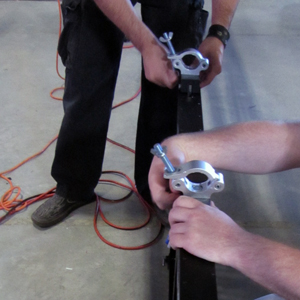 2. What kind of structure are you planning to attach your panels? Are you using truss?
2. What kind of structure are you planning to attach your panels? Are you using truss?
If you are planning to use straight truss, you may want to think about getting some schedule 40 pipe and attaching it to the truss as opposed to hanging your panels directly to the truss. This trick is useful because no matter how well you plan it out, there will always be a cross bar in the way of one or more of the rigging kits. Using the pipe will make that problem go away and you will be able to put your panels exactly where they need to be. As we all know, panel placement is critical to the alignment of the show. If you are using curved truss, you may want to think about using aircraft cable and turnbuckles to trim out your panels. Again, placement is important and as sure as you are reading this, there will be a crossbar in your way.
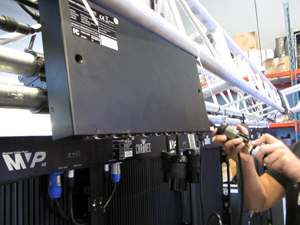 3. How do you plan to run power?
3. How do you plan to run power?
Power for video panels is easy to overlook, and hard to fix if you do. I like to plan exact positions for my power drops in my rig. I also take the step of knowing which circuit powers what device. For example, SOCO 1, Circuit 3 is going to power my stage left stack of 16 MVP 18 panels, which means that Circuit 3 needs to have a powerCON female (blue) connector on it. I can further break that down and use a PowerStream 4 to break that run up a little more. This will also keep my cables cleaner and keep my runs of power much shorter. (I prefer to have my power runs as short as possible.) If you are using a large system, you may have several circuits of power running your system. If that is the case, I strongly suggest running your power from one direction only (left to right, or right to left, as the case may be) so that you can keep your runs clean and simplified. Again, this is where the PowerStream 4 comes in really handy.
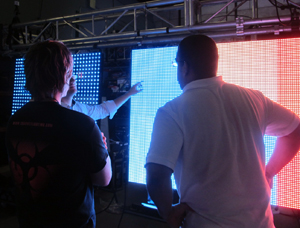 4. How about signal?
4. How about signal?
If you mess up your signal run, you are in for a real bad day. LED Studio—and as far as I am aware, almost every other video panel addressing software—uses the order of signal cabling to locate the position of each panel in your system. It is critical that when you are laying out the signal flow, you follow it exactly. Otherwise correcting this within the software can take hours. You want to have this clear in your preplanning stages.
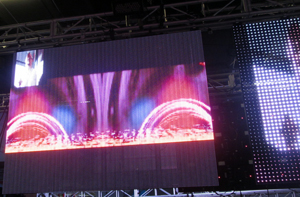 Now you are loading in. The key here is to know your plan and go by it. As long as you do that, you should be fine. There are always bumps along the way, but all in all, should not be that bad. As you put rows of panels in, it is a good idea to power each line and make sure that all of your pixels are working. Use the test button on the back of the panel to turn the panel to white (all LEDs on). This will confirm that you are good to go for LEDs. Once you have that, I would also suggest that every few rows, you send signal and make sure you are getting information from your server to the panels. Send some content to make sure you have your show. The rest of load in is set and repeat.
Now you are loading in. The key here is to know your plan and go by it. As long as you do that, you should be fine. There are always bumps along the way, but all in all, should not be that bad. As you put rows of panels in, it is a good idea to power each line and make sure that all of your pixels are working. Use the test button on the back of the panel to turn the panel to white (all LEDs on). This will confirm that you are good to go for LEDs. Once you have that, I would also suggest that every few rows, you send signal and make sure you are getting information from your server to the panels. Send some content to make sure you have your show. The rest of load in is set and repeat.
Most importantly, be safe in what you are doing. Always keep in mind that you are hanging hundreds of pounds of aluminum, wire, and LEDs in the air above people’s heads. Also, keep in mind that in an outdoor environment, the wind sees a video wall like a big sail. Watch what you are doing. Keep an eye on the weather. Always make sure that your top and side rigging points are secure and no one has left any tools on the panels as they go up in the air.
